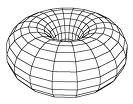Big Problem
The
rising demand for new materials with higher strength to weight ratios has
created a dramatic growth in sandwich composite technology.
Sandwich
construction employs a lightweight core that has a flexural strength and
flexural modulus far exceeding that of the skin laminates alone.
The most
common type of core material is honeycomb which is used primarily for
structural applications in the aerospace industry.
Honeycomb
is a series of cells, nested together to form panels similar in appearance to
the cross-sectional slice of a beehive.
In its expanded form, honeycomb is 90-99 percent open space. Honeycomb is lightweight and has good impact resistance. It offers the best strength to weight ratio of all the core materials.
In its expanded form, honeycomb is 90-99 percent open space. Honeycomb is lightweight and has good impact resistance. It offers the best strength to weight ratio of all the core materials.
However the
main disadvantage of honeycomb type cores used in the Aircraft and Aerospace
industries is that of delamination which can cause a catastrophic failure of
the vehicle.
This is caused primarily by the failure of the epoxy adhesives to maintain a bond between the facing skins and the core because of the very small bonding area that honeycomb cores edges offer.
This is caused primarily by the failure of the epoxy adhesives to maintain a bond between the facing skins and the core because of the very small bonding area that honeycomb cores edges offer.
Standard Honeycomb
This is further exacerbated by the fact that honeycomb type cores create pockets of trapped air within the closed cells of the core when the skins are attached.
The air pressure experienced at high altitudes is much lower than the trapped air within the cells with the result that the skin is pushed away from the inner core by the air pressure.
Ingress of water into already partially delaminated cells at high altitude freeze into ice particles which expand and force the skin to separate from the core.
Eventually after many cyclic operations the skin will delaminate.
Lightning strikes can cause entrapped moisture within the core to immediately turn to steam with catastrophic results to the integral strength of the panels.
The Aerospace Industry remains the greatest consumer
of honeycomb materials, whether for civil aircraft, military jets, helicopters,
aero-engines or the newer space satellite and launchers.
We have now stretched the limits of honeycomb.
We have held onto it because there was nothing better and we are now seeing the inability of aircraft and rocketry to operate successfully.
We have held onto it because there was nothing better and we are now seeing the inability of aircraft and rocketry to operate successfully.
Hexaflex
is a new concept in core design which radically overcomes all of the
disadvantages that are inherent in honeycomb cores.
Instead of being made of single ribbons glued together, Hexaflex is formed from a single sheet or web of core material that has a repeating geometrical design cut out of its surface.
This leaves a flat template design comprising of inter connected hexagons and rectangles. Fig 1.
By employing a series of alternating
folds, the flat design can be folded, concertina style, in upon itself to make
a double-layered core wherein the rectangles form a 45 degree angle to
the hexagons.
 A comparison of the available bonding areas of
standard honeycomb and Hexaflex shows that Hexaflex has a bonding area equal to
the complete area of a hexagon whilst standard honeycomb has a bonding area
equal only to the surfaces of the edges of the hexagon cell it defines.
A comparison of the available bonding areas of
standard honeycomb and Hexaflex shows that Hexaflex has a bonding area equal to
the complete area of a hexagon whilst standard honeycomb has a bonding area
equal only to the surfaces of the edges of the hexagon cell it defines.
The architecture of this core
material, as a product of its design, has open interstitial galley ways spaced
at 120 degrees throughout its thickness.
The Hexaflex core is lacking
in compression strength when compared to standard honeycomb.
This shortcoming is solved by the ability of this design to be injected/infused with syntactic foam into its galley ways, completely filling all voids between the face sheets.
Compression forces can be tailored to optimize the structure by strategically infusing syntactic foam of varying crush strengths.
This shortcoming is solved by the ability of this design to be injected/infused with syntactic foam into its galley ways, completely filling all voids between the face sheets.
Compression forces can be tailored to optimize the structure by strategically infusing syntactic foam of varying crush strengths.
The high crush strength and low density of syntactic foam makes it an ideal core material for sandwich composites.
However shear experiments have showed that the bond between a syntactic foam core and composite face sheets could be a weak link in a sandwich design.
By combining the attributes of Hexaflex and syntactic foam it is possible to create an ultra lightweight core wherein Hexaflex provides the tensile properties and the syntactic foam provides the compression properties.
It may now be possible to eradicate delamination.
It may now be possible to eradicate delamination.













21 COMMENTS:
LINKS TO THIS POST